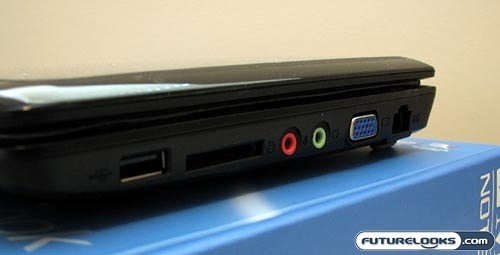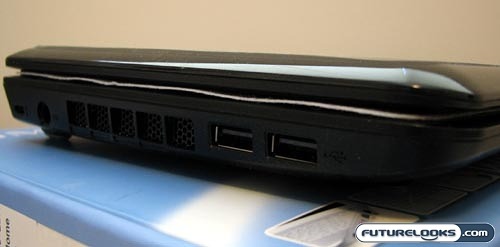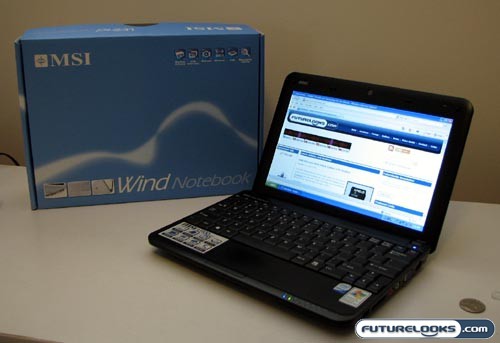First Impressions and Feature Highlights
One of the first things that you’ll notice about the MSI Wind is its relative size. Unlike the original Asus Eee PC, the MSI Wind has a substantially larger keyboard. It’s about 80% the size of a full-size keyboard, so typing on the Wind is a lot easier. I always struggled with the tiny keyboard on the original Eee. The keys were just too small and squished together. Aside from the keyboard, you’ll also notice that the display is a fair size bigger. It’s a ten-inch display with a 1024×600 pixel resolution. This is just enough to render most websites, though you will find that the certain program windows don’t quite fit on the vertical axis.

Regarding the rest of the specifications, you get a 1.6GHz Intel Atom processor, 80GB hard drive, 1GB of RAM, integrated Wi-Fi, integrated Bluetooth, built-in webcam, stereo speakers, and integrated graphics. Along the right side, shown below, you get a single USB port, multi-card reader, headphone and microphone jacks, VGA output, and an Ethernet port.

Along the left side, shown below, you get two USB ports and the port for the power adapter. There are no jacks along the back or the front.

Weighing in at about two or three pounds, including the battery, the MSI Wind is substantially lighter than most larger laptops. This makes it great for portability. It’s also nice that they included a protective case for the subnotebook, though I’m not sure if this is included in the retail package.
Web Surfing and Productivity
Let’s get one thing perfectly clear. The MSI Wind will never be able to replace your regular desktop or laptop computer, nor is it designed to do so. The Wind is a supplementary machine that you can take along during travel or short jaunts around the city. In this way, you probably shouldn’t expect to use the Wind for picture and video editing, intense gaming, or any other processor-intensive task. By and large, you’ll be using it for web surfing, word processing, and other basic tasks.

So, how does it perform? In my terribly unscientific tests, I found that the MSI Wind was a fair bit faster than a smartphone, but it is nowhere close in performance to even a budget notebook. Surfing through the Internet one webpage at a time isn’t horrible, but you may experience some delays depending on the content. If there are a lot of Java applets, advertising, and other things, the load and delay may get a little annoying. I also experience a fair bit of lag when I had more than a couple tabs open in Internet Explorer. I suspect that this is because of a lack of RAM rather than a lack of processing power.
I don’t know about you, but it’s not out of the ordinary for me to have up to ten (or more) tabs open at a time on a regular basis. In this way, I had to dial down my sensory overload when surfing on the MSI Wind. Do it one page at a time with a touch of patience and you’ll be fine. Thankfully, the robustness of the Wi-Fi radio was able to hold up most of the time. I didn’t experience any unexpected cutouts.
On a side note, the MSI Wind was able to maintain a steady connection when I was streaming audio and video through Ustream.tv. It wasn’t any more choppy using the integrated webcam and mic than it would be on my day-to-day laptop, a Dell Inspiron 640m.
Real-Time Price and Stock Check – Check For More Products Here
